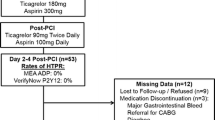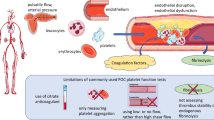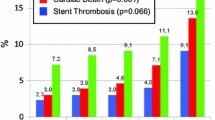Abstract
Until now, the PFA-100® system has been considered unsuitable for monitoring clopidogrel efficacy. The authors evaluated platelet function in peripheral arterial occlusive disease (PAOD) patients using a new PFA-100® test cartridge (product name: INNOVANCE® PFA P2Y*) specifically designed for this purpose. Twenty-two stable PAOD patients on antithrombotic therapy with clopidogrel alone (n = 22) and 18 patients undergoing a peripheral catheter intervention, preliminarily treated with 100 mg/day of aspirin followed by co-administration of clopidogrel (loading dose 300 mg, maintenance dose 75 mg/day), were enrolled in this study. Defining non-responsiveness to clopidogrel as an aggregation response within the reference range (90% central interval), four (18.2%) non-responders using light transmittance aggregometry (LTA) induced by 5 µM adenosine diphosphate (ADP) and six (27.3%) non-responders using LTA induced by 2 µM ADP (LateAggr >72.1% and >42.9%, respectively) were identified. INNOVANCE® PFA P2Y* determined six (27.3%) non-responders (CT < 87 s). Agreement between the two aggregometry assays and INNOVANCE® PFA P2Y* on the definition of clopidogrel response and non-response exceeded 70%. Only three patients were uniformly identified as clopidogrel non-responders by all three assays. When clopidogrel was co-administered with aspirin, two (11.1%) non-responders to clopidogrel were detected with INNOVANCE® PFA P2Y*, whereas ADP-induced LTA found all patients to be responsive. INNOVANCE® PFA P2Y* appears to be suitable for monitoring the effect of clopidogrel on platelet function. Its sensitivity in detecting responsiveness or non-responsiveness to clopidogrel is comparable to ADP-induced LTA. Additional prospective studies are needed to clarify the clinical relevance of the test results and classification obtained with INNOVANCE® PFA P2Y*.


Similar content being viewed by others
References
Born GVR (1962) Aggregation of blood platelets by adenosine diphosphate and its reversal. Nature 194:927–929
Harrison P, Frelinger AL, Furman MI, Michelson AD (2007) Measuring antiplatelet drug effects in the laboratory. Thromb Res 120:323–336
Moffat KA, Ledford-Kraemer MR, Nichols WL, Hayward CPM (2005) Variability in clinical laboratory practice in testing for disorders of platelet function. Results of two surveys of the North American specialized coagulation laboratory asscociation. Thromb Haemost 93:549–553
Snoep JD, Hovens MMC, Eikenboom JC, van der Bom JG, Jukema JW, Huisman MV (2007) Clopidogrel nonresponsiveness in patients undergoing percutaneous coronary intervention with stenting: a systemic review and meta-analysis. Am Heart J 154:221–231
Matetzky S, Shenkman B, Guetta V, Shechter M, Bienart R, Goldenberg I, Novikov I, Pres H, Savion N, Varon D, Hod H (2004) Clopidogrel resistance is associated with increased risk of recurrent atherothrombotic events in patients with acute myocardial infarction. Circulation 109:3171–3175
Hochholzer W, Trenk D, Bestehorn HP, Fischer B, Valina CM, Ferenc M, Gick M, Caputo A, Büttner HJ, Neumann FJ (2006) Impact of the degree of peri-interventional platelet inhibition after loading with clopidogrel on early clinical outcome of elective coronary stent placement. J Am Coll Cardiol 48:1742–1750
Buonamici P, Marcucci R, Migliorini A, Gensini GF, Santini A, Paniccia R, Moschi G, Gori AM, Abbate R, Antoniucci D (2007) Impact of platelet reactivity after clopidogrel administration on drug-eluting stent thrombosis. J Am Coll Cardiol 49:2312–2317
Frere C, Cuisset T, Quilici J, Camoin L, Carvajal J, Morange PE, Lambert M, Juhan-Vague I, Bonnet JL, Alessi MC (2007) ADP-induced platelet aggregation and platelet reactivity index VASP are good predictive markers for clinical outcomes in non-ST elevation acute coronary syndrome. Thromb Haemost 98:838–843
Marcucci R, Paniccia R, Antonucci E, Poli S, Gori AM, Valente S, Giglioli C, Lazzeri C, Prisco D, Abbate R, Gensini GF (2007) Residual platelet reactivity is an independent predictor of myocardial injury in acute myocardial infarction patients on antiaggregant therapy. Thromb Haemost 98:844–851
Snoep JD, Hovens MM, Eikenboom JC, van der Bom JG, Huisman MV (2007) Association of laboratory-defined aspirin resistance with a higher risk of recurrent cardiovascular events. Arch Intern Med 167:1593–1599
Krasopoulos G, Brister SJ, Beattie WS, Elliot RF, Buchanan MR (2008) Aspirin “resistance” and risk of cardiovascular morbidity: systemic review and meta-analysis. Br Med J 336:195–198
Hayward CP, Harrison P, Cattaneo M, Ortel TL, Rao AK (2006) Platelet function analzyer (PFA)-100 closure time in the evaluation of platelet disorders and platelet function. J Thromb Haemost 4:312–319
Jilma B (2001) Platelet function analyzer (PFA-100®): a tool to quantify congenital or acquired platelet dysfunction. J Lab Clin Med 138:152–163
Gachet C (2005) Regulation of platelet functions by P2 receptors. Annu Rev Pharmacol Toxicol 46:277–300
Golanski J, Pluta J, Baraniak J, Watala C (2004) Limited usefulness of the PFA-100 for the monitoring of ADP receptor antagonists—in vitro experience. Clin Chem Lab Med 42:25–29
Mueller T, Haltmayer M, Poelz W, Haidinger D (2003) Monitoring aspirin 100 mg and clopidogrel 75 mg therapy with the PFA-100 device in patients with peripheral arterial occlusive disease. Vasc Endovasc Surg 37:117–123
Paniccia R, Antonucci E, Gori AM, Marcucci R, Giglioli C, Antoniucci D, Gensini GF, Abbate R, Prisco D (2007) Different methodologies for evaluating the effect of clopidogrel on platelet function in high-risk coronary artery disease patients. J Thromb Haemost 5:1839–1847
Geiger J, Teichmann L, Grossmann R, Aktas B, Steigerwald U, Walter U, Schinzel R (2005) Monitoring of clopidogrel action: comparison of methods. Clin Chem 51:957–965
Mani H, Linnemann B, Luxembourg B, Kirchmayr K, Lindhoff-Last E (2006) Response to aspirin and clopidogrel monitored with different platelet function methods. Platelets 17:303–310
Pidcock M, Harrison P (2006) Can the PFA-100 be modified to detect P2Y12 inhibition? J Thromb Haemost 4:1424–1426
Norgren L, Hiatt WR, Dormandy JA, Nehler MR, Harris KA, Fowkes FGR (2007) Inter-Society Consensus for the Management of Peripheral Arterial Disease (TASC II). Eur J Vasc Endovasc Surg 33:S1–S75
Linnemann B, Schwonberg J, Mani H, Prochnow S, Lindhoff-Last E (2008) Standardization of light transmittance aggregometry for monitoring antiplatelet therapy: an adjustment for platelet count is not necessary. J Thromb Haemost 6:677–683
Gum PA, Kottke-Marchant K, Poggio ED, Gurm H, Welsh PA, Brooks L, Sapp SK, Topol EJ (2001) Profile and prevalence of aspirin resistance in patients with cardiovascular disease. Am J Cardiol 88:230–235
Lip GY, Blann A (1997) Von Willebrand factor: a marker of endothelial dysfunction in vascular disorders? Cardiovasc Res 34:255–265
Chakroun T, Gerotziafas G, Robert F, Lecrubier C, Samama MM, Hatmi M, Elalamy I (2004) In vitro aspirin resistance detected by PFA-100 closure time: pivotal role of plasma von Willebrand factor. Br J Haematol 124:80–85
Fuchs I, Frossard M, Spiel A, Riedmüller E, Laggner AN, Jilma B (2006) Platelet function in patients with acute coronary syndrome (ACS) predicts recurrent ACS. J Thromb Haemost 4:2547–2552
Madsen EH, Schmidt EB, Gehr N, Johannesen NL, Kristensen SR (2008) Testing aspirin resistance using the platelet function analyzer-100: some methodological caveats and considerations. J Thromb Haemost 6:386–288
Heilmann EJ, Kundu SK, Sio R, Garcia C, Gomez R, Christie DJ (1997) Comparison of four commercial citrate blood collection systems for platelet function detected by the PFA-100 system. Thromb Res 87:159–164
Marshall PW, Williams AJ, Dixon RM, Growcott JW, Warburton S, Armstrong J, Moores J (1997) A comparison of the effects of aspirin on bleeding time measured using the Simplate method and closure time measured using the PFA-100, in healthy volunteers. Br J Clin Pharmacol 44:151–155
Homoncik M, Jilma B, Hergovich N, Stohlawetz P, Panzer S, Speiser W (2000) Monitoring of aspirin (ASA) pharamcodynamics with the platelet function analyzer PFA-100. Thromb Haemost 83:316–321
Dalby MCD, Davidson RM, Burman JF, Davies SW (2000) Diurnal variation in platelet aggregation with the PFA-100 platelet analyser. Platelets 11:320–324
Cho YU, Jang S, Park CJ, Chi HS (2008) Variables that affect platelet function analyzer-100 (PFA-100) closure times and establishment of reference intervals in Korean adults. Ann Clin Lab Sci 38:247–253
Cunningham MT, Brandt JT, Chandler WL, Eby CS, Hayes TE, Krishnan J, Lefkowitz JB, Olson JD, Stasik CJ, Teruya J, van Cott EM (2007) Quality assurance in haemostasis: the perspective from the College of American Pathologists proficiency testing program. Semin Thromb Haemost 33:250–258
Klein Gunnewiek JM, Hovestad-Witterland AH, Vollaard EJ, Fleuren HW, de Metz M (2005) The influence of acetylsalicylic acid intake by healthy volunteers on duplicate PFA-100 measurements. Blood Coagul Fibrinolysis 16:337–340
Mortensen J, Poulsen TS, Grove EL, Refsgaard J, Nielsen HL, Pedersen SB, Thygesen SS, Hvas AM, Kristensen SD (2008) Monitoring aspirin therapy with the platelet function analyzer-100. Scand J Clin Lab Invest 68:786–792
Andersen K, Hurlen M, Arnesen H, Seljeflot I (2002) Aspirin non-responsiveness as measured by PFA-100 in patients with coronary artery disease. Thromb Res 108:37–42
Linnemann B, Prochnow S, Mani H, Schwonberg J, Lindhoff-Last E (2009) Variability of non-response to aspirin in patients with peripheral arterial occlusive disease during long-term follow-up. Ann Hematol 88:979–988
Crescente M, Di Castelnuovo A, Iacoviello L, Vermylen J, Cerletti C, de Gaetano G (2008) Response variability to aspirin as assessed by the platelet function analyzer (PFA)-100. A systemic review. Thromb Haemost 99:14–26
Reny JL, de Moerloose P, Dauzat M, Fontana P (2008) Use of the PFA-100® closure time to predict cardiovascular events in aspirin-treated cardiovascular patients: a systemic review and meta-analysis. J Thromb Haemost 6:444–450
Disclosures
The study was supported by Siemens Healthcare Diagnostics Products GmbH, Germany, of which Dr. Andreas R. Rechner is an employee.
Author information
Authors and Affiliations
Corresponding author
Additional information
The INNOVANCE® PFA P2Y product is under development—not yet available for sale.
Rights and permissions
About this article
Cite this article
Linnemann, B., Schwonberg, J., Rechner, A.R. et al. Assessment of clopidogrel non-response by the PFA-100® system using the new test cartridge INNOVANCE® PFA P2Y. Ann Hematol 89, 597–605 (2010). https://doi.org/10.1007/s00277-009-0881-9
Received:
Accepted:
Published:
Issue Date:
DOI: https://doi.org/10.1007/s00277-009-0881-9




